| Manufacturer | ReWalk Robotics |
|---|---|
| Year of creation | 2011 (FDA approval) |
| Type | Powered exoskeleton |
| Purpose | Medical |
| Website | www.rewalk.com |
| Nasdaq: RWLK Russell Microcap Index component |
ReWalk is a commercial bionic walking assistance system that uses powered leg attachments to enable paraplegics to stand upright, walk and climb stairs. [1] [2] The system is powered by a backpack battery, and is controlled by a simple wrist-mounted remote which detects and enhances the user's movements. [3] Designed in Yokneam, Israel, by Amit Goffer, [4] the ReWalk is marketed by ReWalk Robotics Ltd (originally Argo Medical Technologies Ltd),[ citation needed ] and is priced at approximately US$85,000 per unit. [5]
The device underwent clinical trials at MossRehab [6] in suburban Philadelphia. [7] In July 2014, ReWalk Robotics filed for an American initial public offering that could raise up to US$58 million. The company is listed on the NASDAQ stock exchange under the symbol "RWLK". [8]
At the time of its initial release, ReWalk was available in two versions – the ReWalk I and the ReWalk P. The ReWalk I is used by medical institutions for research or therapy to be used under the supervision of a healthcare professional. The ReWalk P is for personal use by patients at home or in public.
An updated version, ReWalk Rehabilitation 2.0, was released in January 2013. The ReWalk 2.0 featured improved sizing for taller individuals and some enhancement in controlling software. [9]
The ReWalk system weighs approximately 23.3 kg (51 lb); the backpack containing the system's Windows-operated computer and battery weighs around 2.3 kg (5.1 lb), and the robotic leg attachments weigh around 21 kg (46 lb). [10] The user can engage in three modes: walking, sitting, and standing. The signals to these modes are sent via a wrist-watch type device to the computer. [10]
The first clinical trial for The ReWalk was held at MossRehab [11] located in Philadelphia in 2009. The ReWalk was approved for hospital use in the United States by the Food and Drug Administration (FDA) in 2011. [3] FDA approval for home and public use was issued in June 2014. [12] [13] ReWalk is also the first exoskeleton to receive FDA clearance for personal and rehabilitation use in the United States. [14]
In 2010, a prototype ReWalk appeared in the American TV series Glee ; the exoskeleton is used by fictional character Artie Abrams during the Season 2 episode "A Very Glee Christmas". [15] [16]
On 8 May 2012, paralyzed British woman Claire Lomas became the first person to finish a marathon using a bionic assistance suit. Lomas, who was paralyzed from the waist down in a 2007 riding accident, completed the London Marathon in 17 days with her ReWalk system. [17] Later in 2012, Lomas became the first person to take the ReWalk suit home for assistance with everyday tasks, [18] and participated in the opening ceremony of the 2012 Summer Paralympics in her ReWalk. [19]
By 2015, Japanese robotics maker Yaskawa Electric Co. has been distributing ReWalk in Asia, i.e. China, under a deal signed in 2014 with ReWalk Robotics. However, in Japan itself ReWalk faces a long approval process that is typical for Japanese businesses. [20] [21] This is due to tight regulation laws in Japan that has been in effect for the last decade. [22]
The weight and bulk of the ReWalk exoskeleton is considered to be too much for some users by its creator, Amit Goffer. [4] In addition, with a price of between US$69,500 [10] to US$85,000, [5] the system is beyond the reach of many patients, especially because, as of July 2014, health insurance in the United States does not yet cover the ReWalk. [10] Larry Jasinki, the CEO of ReWalk, stated in 2014 that the company is "working with insurers and other health-care coverage providers to ensure individuals eligible to use the ReWalk are able to purchase a system". [10]
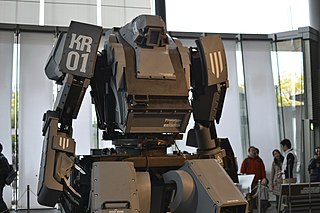
In science fiction, mecha or mechs are giant robots or machines typically depicted as piloted and as humanoid walking vehicles. The term was first used in Japanese after shortening the English loanword 'mechanism' or 'mechanical', but the meaning in Japanese is more inclusive, and 'robot' or 'giant robot' is the narrower term.

The Hybrid Assistive Limb is a powered, soft-bodied exoskeleton suit developed by Japan's Tsukuba University and the robotics company Cyberdyne. It is designed to support and expand the physical capabilities of its users, particularly people with physical disabilities. There are two primary versions of the system: HAL 3, which only provides leg function, and HAL 5, which is a full-body exoskeleton for the arms, legs, and torso.
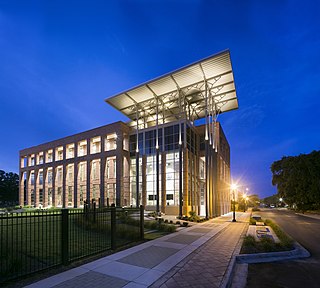
The Florida Institute for Human & Machine Cognition (IHMC) is a not-for-profit research institute of the State University System of Florida, with locations in Pensacola and Ocala, Florida. IHMC scientists and engineers investigate a broad range of topics related to building systems aimed at amplifying and extending human cognitive, physical and perceptual capacities.
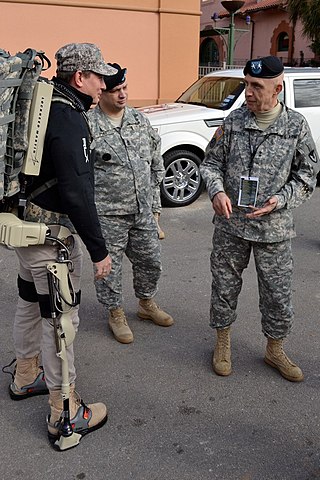
Human Universal Load Carrier, or HULC, is an un-tethered, hydraulic-powered anthropomorphic exoskeleton developed by Professor H. Kazerooni and his team at Ekso Bionics. It is intended to help soldiers in combat carry a load of up to 200 pounds at a top speed of 10 miles per hour for extended periods of time. After being under development at Berkeley Robotics and Human Engineering Laboratory since 2000, the system was announced publicly at the AUSA Winter Symposium on February 26, 2009, when an exclusive licensing agreement was reached with Lockheed Martin. Although the exoskeleton is powered and can be used, the project was a failure as it hindered certain movements and actually increased strain on muscles, going directly against what a powered exoskeleton is supposed to do.

SoldierStrong is a Stamford, Connecticut based 501(c)(3) charitable organization whose mission is to improve the lives of the men and the women of the United States Armed Forces.

A powered exoskeleton is a mobile machine that is wearable over all or part of the human body, providing ergonomic structural support and powered by a system of electric motors, pneumatics, levers, hydraulics or a combination of cybernetic technologies, while allowing for sufficient limb movement with increased strength and endurance. The exoskeleton is designed to provide better mechanical load tolerance, and its control system aims to sense and synchronize with the user's intended motion and relay the signal to motors which manage the gears. The exoskeleton also protects the user's shoulder, waist, back and thigh against overload, and stabilizes movements when lifting and holding heavy items.

Christopher Meek is an American philanthropist and finance executive and author. Meek is the co-founder and chairman of SoldierStrong, a charitable organization which provides support for U.S. service members and veterans. He is also the co-founder and chairman of START Now!, a non-profit which provides foreclosure counseling to homeowners. He is also the managing director of global relationship management at S&P Global and a member of the Maxwell School Advisory Board at Syracuse University.
Homayoon Kazerooni is an Iranian-born American roboticist, mechanical engineering, and professor. He serves as a professor of mechanical engineering, and the director of the Berkeley Robotics and Human Engineering Laboratory at the University of California, Berkeley. Kazerooni is also the co-founder of Ekso Bionics and SuitX. As a noted authority on robotics, he is frequently profiled and quoted in the media.

Ekso Bionics Holdings Inc. is a company that develops and manufactures powered exoskeleton bionic devices that can be strapped on as wearable robots to enhance the strength, mobility, and endurance of industrial workers and people experiencing paralysis and mobility issues after a brain injury, stroke, multiple sclerosis (MS) or spinal cord injury. They enable individuals with any amount of lower extremity weakness, including those who are paralyzed, to stand up and walk.
Berkeley Robotics and Human Engineering Laboratory is managed and operated by University of California, Berkeley. The lab conducts scientific research on the design and control of a class of robotic systems worn or operated by humans to increase human mechanical strength.
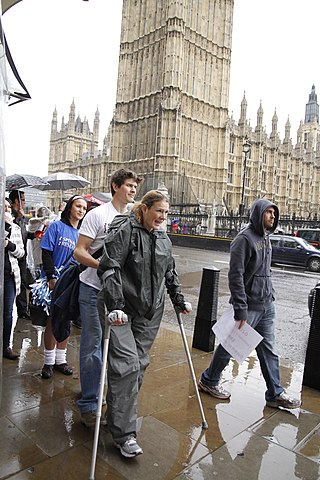
Claire Lomas is a British campaigner, fundraiser, motivational speaker and former event rider. She became a paraplegic as a result of a riding accident in 2007. In 2012, she finished the 32nd Virgin London Marathon in 17 days using the ReWalk robotic suit.
The Vanderbilt exoskeleton, marketed as Indego, is a powered exoskeleton designed by the Center for Intelligent Mechatronics at Vanderbilt University in the U.S. state of Tennessee. It is intended to assist paraplegics, stroke victims and other paralyzed or semi-paralyzed people to walk independently. Motion and control technologies manufacturer Parker Hannifin is funding further development, and plans to release the first commercial version of the exoskeleton in 2015.
Neuromechanics of orthoses refers to how the human body interacts with orthoses. Millions of people in the U.S. suffer from stroke, multiple sclerosis, postpolio, spinal cord injuries, or various other ailments that benefit from the use of orthoses. Insofar as active orthoses and powered exoskeletons are concerned, the technology to build these devices is improving rapidly, but little research has been done on the human side of these human-machine interfaces.

Cybathlon, a project of ETH Zurich, acts as a platform that challenges teams from all over the world to develop assistive technologies suitable for everyday use with and for people with disabilities. The driving force behind CYBATHLON is international competitions and events, in which teams consisting of technology developers from universities, companies or NGOs and a person with disabilities (pilot) tackle unsolved everyday tasks with their latest assistive technologies. Besides the actual competition, the Cybathlon offers a benchmarking platform to drive forward research on assistance systems for dealing with daily-life challenges, and to promote dialogue with the public for the inclusion of people with disabilities in society. The involvement of the pilot is considered essential both to the competition and in the development process, to ensure that the perspective and needs of end users are considered and addressed.
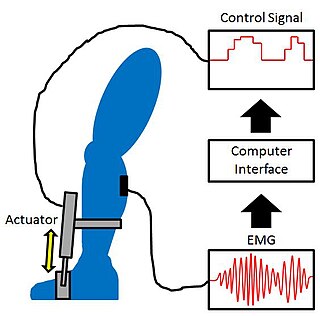
Proportional myoelectric control can be used to activate robotic lower limb exoskeletons. A proportional myoelectric control system utilizes a microcontroller or computer that inputs electromyography (EMG) signals from sensors on the leg muscle(s) and then activates the corresponding joint actuator(s) proportionally to the EMG signal.
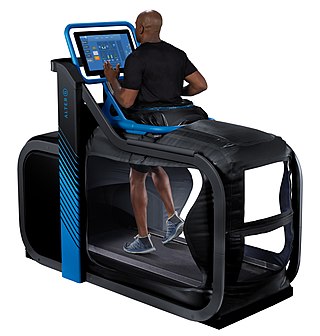
AlterG, Inc. is a medical device company that makes mobility enhancement products for physical therapy and athletic training. Its first product, the Anti-Gravity Treadmill, now has a product line that includes the M/F320, Via 400 and 400X, and Pro 200 and 500.

Unison Healthcare Group, started out as "Unison" (友信行), is a Taiwanese medical device distributor founded in 1955, headquartered in Taipei. The corporation provides equipment and systems ranging from radiology, cardiology, orthopedic, telemedicine, medical imaging to medical robots. It is also a turnkey project and total solution provider for hospitals, offering overseas technical support in over 45 countries, such as Mainland China, Mongolia, Vietnam and Thailand.
Robotics in Italy is a high technology area where Italy hosts numerous research centers.
MossRehab is a physical rehabilitation hospital and other centers located in the Philadelphia region of Pennsylvania that opened in the early 1900s as part of the original Jewish Hospital. Moss became an independent facility in 1952. During the 1990s, MossRehab merged back into the Einstein Healthcare Network. MossRehab's Main Campus is located at 60 Township Line Road, Elkins Park, Pennsylvania.
A soft exoskeleton, also known as a soft wearable robot or a soft robotic exosuit, is a type of wearable robotic device designed to augment and enhance the physical abilities of the human body. Unlike traditional rigid exoskeletons, which are typically made of hard materials like metal and are worn over the user's limbs, soft exoskeletons are constructed from flexible and lightweight materials. Soft exoskeletons are designed to assist individuals with mobility impairments, aid in rehabilitation, augment human performance, and improve overall quality of life.